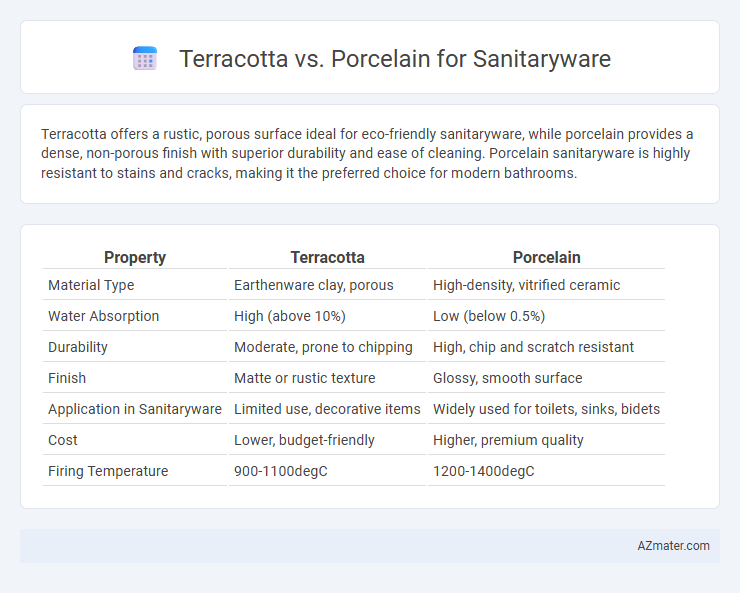Terracotta offers a rustic, porous surface ideal for eco-friendly sanitaryware, while porcelain provides a dense, non-porous finish with superior durability and ease of cleaning. Porcelain sanitaryware is highly resistant to stains and cracks, making it the preferred choice for modern bathrooms.
Table of Comparison
| Property | Terracotta | Porcelain |
|---|---|---|
| Material Type | Earthenware clay, porous | High-density, vitrified ceramic |
| Water Absorption | High (above 10%) | Low (below 0.5%) |
| Durability | Moderate, prone to chipping | High, chip and scratch resistant |
| Finish | Matte or rustic texture | Glossy, smooth surface |
| Application in Sanitaryware | Limited use, decorative items | Widely used for toilets, sinks, bidets |
| Cost | Lower, budget-friendly | Higher, premium quality |
| Firing Temperature | 900-1100degC | 1200-1400degC |
Introduction to Sanitaryware Materials
Terracotta and porcelain are two prominent materials used in sanitaryware, each offering distinct properties tailored for bathroom fixtures. Terracotta is a natural clay-based ceramic known for its porosity and rustic appearance, requiring sealing for hygiene and durability. Porcelain, a refined and highly vitrified ceramic, excels in water resistance, strength, and smooth finish, making it the preferred choice for sinks, toilets, and bathtubs with enhanced longevity and ease of maintenance.
Understanding Terracotta: Composition and Characteristics
Terracotta for sanitaryware is composed primarily of natural clay fired at lower temperatures, resulting in a porous, earthy material with a characteristic reddish-brown hue. Its high porosity makes it less durable and more absorbent than porcelain, requiring a protective glaze for water resistance and stain prevention. The rustic aesthetic and softer texture differentiate terracotta from the dense, vitrified composition of porcelain, which is fired at much higher temperatures for superior strength and impermeability.
Porcelain: Properties and Benefits
Porcelain sanitaryware is highly durable, non-porous, and resistant to stains, making it an ideal choice for bathrooms and kitchens. Its smooth, glass-like surface ensures easy cleaning and long-lasting hygiene by preventing the growth of bacteria and mold. Additionally, porcelain's superior strength and low water absorption rate contribute to its enhanced durability and aesthetic appeal compared to terracotta alternatives.
Durability Comparison: Terracotta vs Porcelain
Terracotta sanitaryware offers a natural, rustic appeal but is less durable due to its porous structure, making it more susceptible to cracking and staining over time. Porcelain sanitaryware, fired at higher temperatures, provides superior durability with increased resistance to chipping, scratching, and moisture absorption. The dense, vitrified surface of porcelain ensures long-lasting performance, especially in high-use bathroom fixtures where durability is critical.
Water Absorption and Stain Resistance
Terracotta sanitaryware exhibits higher water absorption, typically above 5%, making it more porous and susceptible to moisture penetration compared to porcelain, which has water absorption rates below 0.5%. Porcelain's dense, vitrified composition offers superior stain resistance, preventing discoloration from common bathroom substances, whereas terracotta is more prone to staining without proper glazing. These characteristics make porcelain a preferred choice for durability and hygiene in sanitary fixtures where low porosity and stain resistance are critical.
Aesthetic Appeal: Color, Finish, and Design Options
Terracotta sanitaryware offers a warm, earthy aesthetic with rich, natural tones and a matte, textured finish that enhances rustic and traditional bathroom designs. Porcelain sanitaryware provides a sleek, smooth surface with a wide range of vibrant colors and glossy or satin finishes, allowing for versatile, modern, and minimalist styles. Design options in porcelain include intricate patterns and precise shapes due to its fine composition, while terracotta emphasizes handcrafted, artisanal appeal with unique imperfections.
Maintenance and Cleaning Requirements
Terracotta sanitaryware requires regular sealing to prevent water absorption and staining, making maintenance more frequent compared to porcelain. Porcelain offers superior non-porous surfaces that resist stains, mold, and bacteria, reducing the need for intensive cleaning and sealing. The durability of porcelain ensures easier upkeep and longer-lasting aesthetic appeal in sanitaryware applications.
Cost Analysis: Budget Considerations
Terracotta sanitaryware often costs less upfront due to lower material and manufacturing expenses, making it a budget-friendly option for basic installations. Porcelain, while generally more expensive, offers higher durability, stain resistance, and a longer lifespan, which can reduce replacement and maintenance costs over time. Evaluating total cost of ownership including installation, maintenance, and durability is critical when choosing between terracotta and porcelain for sanitaryware projects.
Environmental Impact and Sustainability
Terracotta sanitaryware is made from natural clay and fired at lower temperatures, resulting in a reduced carbon footprint compared to porcelain, which requires higher firing temperatures and more energy. Porcelain offers greater durability and water resistance, potentially lowering replacement frequency and waste generation over time. Choosing terracotta supports sustainable production with fewer emissions, while porcelain complements sustainability through longevity and efficient maintenance in sanitary applications.
Choosing the Right Material for Your Bathroom
Terracotta offers a rustic and porous texture ideal for traditional bathroom designs, providing natural warmth but requiring sealing to prevent water absorption and staining. Porcelain, known for its dense, non-porous composition, delivers superior durability, stain resistance, and easy maintenance, making it a preferred choice for modern sanitaryware. Selecting the right material depends on balancing aesthetic preferences with functionality, where porcelain suits high-traffic or moisture-prone areas, while terracotta adds a distinctive tactile charm to less exposed spaces.

Infographic: Terracotta vs Porcelain for Sanitaryware
 azmater.com
azmater.com